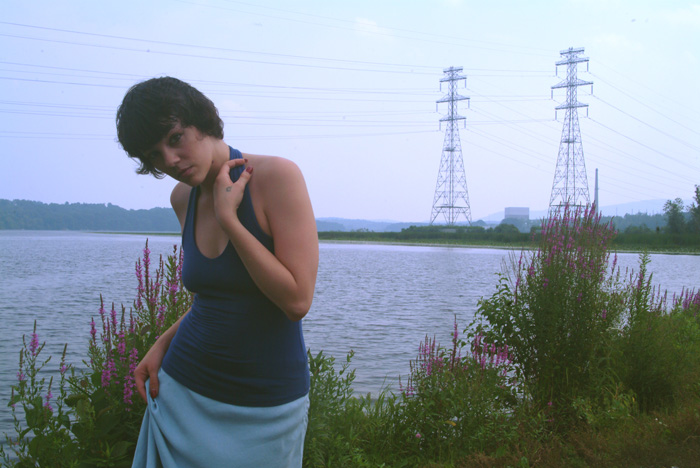 Living in the shadow of the Vermont Yankee Nuclear Reactor.
Living in the shadow of the Vermont Yankee Nuclear Reactor.(model Isabel Vinson)
To live within a few miles of a working nuclear reactor entails certain distinct factors worthy of notation to people who live further away. This paper intends to draw some attention to those differences.
Every reactor zone has evacuation plans and reception centers that are prepared in the event of a radiological release. The evacuation plans are not tested due to the level of alarm it would supposedly instill in people, in addition to the market disturbance that would occur during those times the evacuation plan was being tested. For ten, twenty thousand or more residents of an area to evacuate would upset business and create a liability for the town sponsoring the evacuation drill. The functioning of the reception centers including their ability to radiologically decontaminate individuals is tested by the state emergency management teams These state emergency management agencies answer to the Federal Emergency Management Agency on a yearly basis. Whether the plans actually work or not is irrelevant, as each year FEMA is informed that an effective plan is in place. The plans are, at best, minimally tested.
For example the plans in Brattleboro VT have been deemed successful when it only takes only 1 hour and 40 minutes to load the public school children on to buses, which is better than having the buses neglect to pick up children as in earlier tests. Brattleboro is 5 miles from the reactor If the buses arrive in longer than 45 minutes it is too long. Furthermore, the drills have not taken into account the private school students, hospital residents, emergency traffic conditions, nursing home residents, indigent population etc. To have called such a drill a success is stretching the truth.
The town government of Brattleboro, VT. has a mandate to approve the town evacuation plan as each year. To date it has not been approved since May of 2001. The former selectboard had received a “nuclear 101” course from a non local retired nuclear engineer and still the approval /disapproval of the evacuation plan has been avoided.
The general public in reactor zone towns are offered free weather alert radios here in VT. These are devices that warn of impending bad weather from the National Weather Service and also of any significant radiological releases. These radios are often available from either the local fire departments or from the city/town halls. The upside to these is the ability to know of an event when one may not be listening to the am/fm radio. The weather alert radio when set to the correct frequency comes on of its own accord. The downside is that these radios are tested, by either the national weather service or the local emergency management team at often inopportune moments. For one who works second shift to have ones’ sleep disturbed by the weather alert radio test at 0600 hours is frustrating yet also in a way comforting.
Once each month there are siren tests. These sirens are placed in the emergencyprotective zone ten within the ten mile radius of the reactor. These sirens are akin to the old air raid sirens to warn of blitzkrieg or to warn of missile attack. They are loud – last for a few minutes – and unfortunately many people take the sound of them for granted while they continue shopping.
The states in the epz- (emergency planning zone) receive for the towns in the epzfrom the federal government a supply of potassium iodide (KI) to distribute to its residents. Residents only receive the KI tablets when they apply through the state office of the department of public health. Potassium iodide is an after the fact (of a radiological release) option. In the event of a significant release of radionucleides, if one ingests the KI one can protect their thyroid gland. The thyroid gland is part of the endocrine system and the KI basically packs the thyroid gland with stable iodine so that it does not absorb the radioactive iodine. Radioactive iodine enters the environment anytime “spent fuel rods” are handled or when nuclear weapons are used. Iodine 129, one of the radioactive iodines, has a half-life of millions of years. KI is not effective if radioactive iodine is not one of the radioisotopes released.
Living in the shadow of a nuclear reactor could be written as a nightmare tale ending in either “I told you so” or “thank goodness we haven’t needed to use the evacuation plan yet”. Within a few days of the Three Mile Island partial meltdown, March 28, 1979, 2000 people were asked to evacuate. Thirty thousand plus people hit the roads. This phenomenon is called shadow evacuation.
Because the industry is so confident of its defense in depth, nuclear workers tend to think that an accident is near impossible. On the other hand, with older reactors now being asked to produce more power for longer than they were originally designed a nuclear accident is not just a likelihood but is inevitable. It isan eventuality. The longer the current generation of reactors is pushed the greater the likelihood of our not avoiding a catastrophic accident. May no one be harmed as a consequence. Unfortunately, if no one is harmed, the catastrophic qualities of the accident may be overlooked.

1 comment:
That was very well written... Nice
Post a Comment